Commitment
Climate Emergency Institute
The 2014 IPCC assessment estimated the commitment due to atmospheric greenhouse gases at 2.0°C.
The commitment from constant greenhouse gas concentrations would correspond to approximately 2C warming IPCC AR5 WG1 Chapter 12, 12.5.2. page 1108.. The IPCC AR5 estimates that commitment is at least an extra 0.6C by 2100 and over another 1C by 2300.
That is now over 2°C.
'AOGCMs estimated a most likely value of about 0.6°C for 2100 (relative to 1980–1999, AR4). CMIP5 results are consistent with those numbers, with an additional warming of about 0.5°C 200 years after stabilization of the forcing'. (AR5 WG1 CH12 p 1103). This does not include amplifying feedbacks.
This IPCC commitment does not include the extra warming from amplifying feedbacks in any of its projections.
'However, this equilibrium estimate is based on feedbacks estimated for the present day climate. Climate and carbon cycle feedbacks may increase substantially on long time scales and for high cumulative CO2 emissions' (IPCC AR5 WG1 Ch.12 p.1109).
That is now over 2°C.
'AOGCMs estimated a most likely value of about 0.6°C for 2100 (relative to 1980–1999, AR4). CMIP5 results are consistent with those numbers, with an additional warming of about 0.5°C 200 years after stabilization of the forcing'. (AR5 WG1 CH12 p 1103). This does not include amplifying feedbacks.
This IPCC commitment does not include the extra warming from amplifying feedbacks in any of its projections.
'However, this equilibrium estimate is based on feedbacks estimated for the present day climate. Climate and carbon cycle feedbacks may increase substantially on long time scales and for high cumulative CO2 emissions' (IPCC AR5 WG1 Ch.12 p.1109).
Inertias This includes a number of inertias also uncertainties: political obstructive inertia, inertia from governments setting policies to phase out fossil fuels, legislative and economic inertia for policy to take effect on emissions, technological inertia to replace all fossil fuel energy with renewable energy, higher climate sensitivity that the best guess 3°C (the upper IPCC range and various research approaches yield 4.5°C and some up to 6C) above, unmasking of fossil fuel air pollution aerosol cooling (could be an extra 1C from 2016 research. Reto Knutti, 2015, Reto Knutti, 2015, ocean heat lag inertia (the degree is uncertain), land and ocean carbon sink failure (timing uncertain), and amplifying feed-backs (responses to global warming that are excluded from the projections). The latter will increase with temperature and time may be very large. A future commitment based on the single climate sensitivity of 3°C and excluding large amplifying feed-backs is a very low estimate and wrong for policy making (2015 Reto Knutti , Feedbacks, climate sensitivity and the limits of linear models,Phil. Trans. R. Soc. A.).
Today the world is committed to a massively changed and increasingly hostile natural world (already evident from 1°C) and could be committed to a future uninhabitable planet, due to combinations of the above triggering multiple huge planetary sources of combined inter-reinforcing extra feedback warming.
Definition There is no single agreed upon definition or derivation of climate change commitment in the science, and commitment has not been used for policy making.
It is agreed that the crucial committed duration of global warming is over 1000 years.
Policy commitment The national emissions targets that have not improved since the 2015 Paris Agreement, lead to global warming of at least 3°C by 2100, which is 4.2°C by 2300.
Long term committed impacts of global warming are therefore huge, because they increase with global temperature and with time. This has not featured prominently in the science. Carbon feedback emissions that add to the warming will continue increasing for centuries and will increase extreme weather events including forest fires. The loss of Arctic summer sea ice and Far North snow cover (cooling albedo) is a large commitment to a transformed climate system, in particular increasing Northern hemisphere extremes. It will increase global warming directly and by increasing Arctic carbon feedback emissions. Ocean heating, acidification and de-oxygenation with continue for thousands of years as will sea level rise. The only way to limit these to come extent is by immediate (2020) rapid decline in emissions (RCP2.6 in the IPCC AR5 and P1 in the 1.5°C Report), otherwise IPCC 2014 shows they all carry on increasing. So any delay from this time on in putting emissions into rapid decline increases future committed warming.
Constant Composition Climate system inertia means there is more heat in the climate system than registers as the realized global surface temperature increase. This committed extra warming (constant composition) is the result of the fact that by far the most of the added lower atmosphere greenhouse gas heat energy goes to the vast oceans. As far back as the IPCC 1990 1st assessment this has been put at double realized warming (2°C by IPCC AR5), but this is being regarded now as misleadingly high with respect to today. "The warming commitment from past CO2 emissions is small, and future warming will largely be determined by current and future CO2 emissions. Each additional CO2 emission will contribute to warming that will persist almost indefinitely" (2013, K. Zickfeld). The science does agree that global warming by 2100 will be committed to to increase more long after 2100 as in the IPCC 2014 RCP scenarios extended from 2100 to 2300. Also it is agreed that at 1C today we are committed to 1.5°C to 2°C, i.e another 50% to 100% of realized warming.
By including extra feedback warming (excluded in projections) double realized warming has a high certainty. Land warming alone (excluding peat and permafrost) is estimated at up to 1.5°C by 2100 ( 2012, Ben. B. Booth, High sensitivity of future global warming to land carbon cycle processes).
A lot of the science and policy of commitment consideration is moot if we consider runaway (which is essential), leading to an unavoidable 'hot house Earth'. Permafrost leads to runaway because as it thaws it generates heat from microbial carbon digestion. Over the long term it can add another 3.5°C to global warming (2013, K. Zinkfeld) This is a big reason for the old 2°C limit (limit now is 1.5°C) and the Hothouse Earth paper also put the runaway danger limit at 2°C. If There is research that puts this limit at 1.5°C (A. Vaks, 2013, A. McDougall 2012). The Arctic alone holds double all atmospheric carbon. This makes a commitment today of 1.5°C to 2°C an extreme hot house Earth commitment to an unlivable planet.
By all definitions of commitment, 1.5°C is locked-in. "Expert judgement suggests that if all anthropogenic emissions were reduced to zero immediately, any further warming beyond the 1°C already experienced would likely be less than 0.5°C over the next two to three decades, and centuries (IPCC 2018 1.5°C ch 1)
A lot of the science and policy of commitment consideration is moot if we consider runaway (which is essential), leading to an unavoidable 'hot house Earth'. Permafrost leads to runaway because as it thaws it generates heat from microbial carbon digestion. Over the long term it can add another 3.5°C to global warming (2013, K. Zinkfeld) This is a big reason for the old 2°C limit (limit now is 1.5°C) and the Hothouse Earth paper also put the runaway danger limit at 2°C. If There is research that puts this limit at 1.5°C (A. Vaks, 2013, A. McDougall 2012). The Arctic alone holds double all atmospheric carbon. This makes a commitment today of 1.5°C to 2°C an extreme hot house Earth commitment to an unlivable planet.
By all definitions of commitment, 1.5°C is locked-in. "Expert judgement suggests that if all anthropogenic emissions were reduced to zero immediately, any further warming beyond the 1°C already experienced would likely be less than 0.5°C over the next two to three decades, and centuries (IPCC 2018 1.5°C ch 1)
If there is no rapid 2020 global emissions decline, over 2°C is committed just by 2100. 2C by 2100 is 2.4°C by 2300, but that excludes inevitable extra feedback emissions, and so excludes runaway.
Policy commitment The best known estimated commitment perhaps is that due to today's polices (energy and climate) For Policy Commitment (PC) we can use the current and projected actual trend in emissions, and near term economic and energy policies. We are tracking closest to the worst case emissions scenario (37.1 Gt. CO2 2018 Global Carbon Project), RCP 8.5 in the 2014 IPCC 5th assessment (AR5) or SRES A1FI in the 2007 4th assessment (AR4). This puts us at about 4.5°C (only) by 2100 and it excludes inevitable extra warming from amplifying feedback emissions (e.g. thawing permafrost). The limitation of projected warming to 2100 and exclusion of carbon feedback emissions warming, reflects the current economic bias of policy and science against rights for future generations.
Today that means a large and growing risk of a climate legacy of an unlivable or even uninhabitable planet.
All energy policies and plans are for very little change in the dominant share of fossil fuel energy (at least 80%) over the next few decades. With the advent of shale oil and gas there is no fossil fuel supply limitation. There is no climate policy being applied to change that. National non binding emissions targets filed wit the UN (INDCs) lead to a substantial increase in emissions by 2030 (UNEP GAP Report 2018, Climate Action Tracker 2018), and those are not being followed because actual CO2 emissions are tracking the worst case scenario.
Geoengineering Commitment cannot be reduced by geoengineering. Assuming large removals of CO2, for which the only evidence is that this is not feasible is wrong in every way. IPCC climate science improperly assumes artificial CO2 removal in its scenarios, except for the best case RCP and 1.5C scenarios. Geoengineering to cool the planet or remove CO2 at best can only bring about small effects and come with disastrous side effects. Direct air capture would be safe but removing CO2 at scale impossible.
Practical climate system commitment. The best practical climate system definition would be the very long term warming resulting from the best possible mitigation today (no CO2 removal as we have no capacity today) which we could call practical climate system commitment (PCSC). Though this is generally not recognized as such by the science it can be derived from the science.
IPCC 2018 1.5°C The latest IPCC estimate of future committed climate change is from the 2018 1.5C Report, and it concludes the 1.5°C limit is barely achievable. "Given that global temperature is currently rising by 0.2°C (±0.1°C) per decade, human-induced warming reached 1°C above pre-industrial levels around 2017 and, if this pace of warming continues, would reach 1.5°C around 2040". However the 1.5°C Report model projections.
If there is no rapid 2020 global emissions decline, over 2°C is committed just by 2100. 2C by 2100 is 2.4°C by 2300, but that excludes inevitable extra feedback emissions, and so excludes runaway.
Policy commitment The best known estimated commitment perhaps is that due to today's polices (energy and climate) For Policy Commitment (PC) we can use the current and projected actual trend in emissions, and near term economic and energy policies. We are tracking closest to the worst case emissions scenario (37.1 Gt. CO2 2018 Global Carbon Project), RCP 8.5 in the 2014 IPCC 5th assessment (AR5) or SRES A1FI in the 2007 4th assessment (AR4). This puts us at about 4.5°C (only) by 2100 and it excludes inevitable extra warming from amplifying feedback emissions (e.g. thawing permafrost). The limitation of projected warming to 2100 and exclusion of carbon feedback emissions warming, reflects the current economic bias of policy and science against rights for future generations.
Today that means a large and growing risk of a climate legacy of an unlivable or even uninhabitable planet.
All energy policies and plans are for very little change in the dominant share of fossil fuel energy (at least 80%) over the next few decades. With the advent of shale oil and gas there is no fossil fuel supply limitation. There is no climate policy being applied to change that. National non binding emissions targets filed wit the UN (INDCs) lead to a substantial increase in emissions by 2030 (UNEP GAP Report 2018, Climate Action Tracker 2018), and those are not being followed because actual CO2 emissions are tracking the worst case scenario.
Geoengineering Commitment cannot be reduced by geoengineering. Assuming large removals of CO2, for which the only evidence is that this is not feasible is wrong in every way. IPCC climate science improperly assumes artificial CO2 removal in its scenarios, except for the best case RCP and 1.5C scenarios. Geoengineering to cool the planet or remove CO2 at best can only bring about small effects and come with disastrous side effects. Direct air capture would be safe but removing CO2 at scale impossible.
Practical climate system commitment. The best practical climate system definition would be the very long term warming resulting from the best possible mitigation today (no CO2 removal as we have no capacity today) which we could call practical climate system commitment (PCSC). Though this is generally not recognized as such by the science it can be derived from the science.
IPCC 2018 1.5°C The latest IPCC estimate of future committed climate change is from the 2018 1.5C Report, and it concludes the 1.5°C limit is barely achievable. "Given that global temperature is currently rising by 0.2°C (±0.1°C) per decade, human-induced warming reached 1°C above pre-industrial levels around 2017 and, if this pace of warming continues, would reach 1.5°C around 2040". However the 1.5°C Report model projections.
For IPPC 1.5°C Report best-case scenario is P1, which is essentially the same as RCP2.6 best case 2014 IPCC 5th assessment scenario. P1 does not go beyond 2100 and assumes effective natural CO2 removal from land use uptake by increasing the the land sink and reducing land emissions (forestry and agriculture). RCP 2.6 in AR5 is projected beyond 2100 but assumes constant CO2 removal to stay below 2°C.
Geophysical warming commitment is defined as the unavoidable future warming resulting from physical Earth system inertia. Different variants are discussed in the literature, including (1) the ‘constant composition commitment’ (CCC) as the further warming that would result if atmospheric concentrations of GHGs and other climate forcers were stabilised at the current level. The CCC is primarily associated with thermal inertia of the ocean. The IPCC says the CCC takes into account the warming from past emissions, but also includes warming from future emissions (declining but still non-zero) that are required to maintain a constant atmospheric composition.
The ‘zero emissions commitment’ (ZEC) (2) is no commitment.
It is defined as the further warming that would still occur if all future anthropogenic emissions of greenhouse gases and aerosol precursors were eliminated instantaneously. That is clearly no commitment assessment or for policy.
Present-day CO2-induced warming is irreversible on millennial time scales
Geophysical warming commitment is defined as the unavoidable future warming resulting from physical Earth system inertia. Different variants are discussed in the literature, including (1) the ‘constant composition commitment’ (CCC) as the further warming that would result if atmospheric concentrations of GHGs and other climate forcers were stabilised at the current level. The CCC is primarily associated with thermal inertia of the ocean. The IPCC says the CCC takes into account the warming from past emissions, but also includes warming from future emissions (declining but still non-zero) that are required to maintain a constant atmospheric composition.
The ‘zero emissions commitment’ (ZEC) (2) is no commitment.
It is defined as the further warming that would still occur if all future anthropogenic emissions of greenhouse gases and aerosol precursors were eliminated instantaneously. That is clearly no commitment assessment or for policy.
Present-day CO2-induced warming is irreversible on millennial time scales
Climate Sensitivity All commitment estimates are unrealistically low because they are based on a single climate sensitivity of 3°C, while under further warming it will increase degree by degree over time
NO CO2 removal Any true definition of commitment does not include assumed successful CO2 removal which is not feasible today of the foreseeable future and in any case is not economically feasible without a large carbon tax.
Permafrost commitment (at 1°C) Permafrost is the largest single certain source of GHG feedback emissions caused by global surface warming, holding double atmospheric carbon. Permafrost thawing generates its own internal heat, making it irreversible. By a global warming of 1°C, Arctic permafrost feedback emissions of methane, CO2 and nitrous oxide are well established. Therefore a sustained warming of over 1°C, will eventually lead to irreversibly and increasing GHG permafrost feedback emissions. The sea-ice decline amplifying feedback will further boost these GHG feedback emissions. This requires emergency Arctic intervention intervention. Permafrost feedback is not included in IPCC temperature projections.
2°C is climate runaway commitment
For long the climate runaway danger trigger danger limit has been 2°C, and recent research puts the trigger at over 1.5°C. Any form of commitment over 2°C is an end of the world commitment. Projecting impacts above 2°C is a dangerous delusion, risking the future survival of the human race.
The IPCC science warming projections are very large under-estimates, which we will call "basic".
The IPCC science warming projections are very large under-estimates, which we will call "basic".
1. Feedback extra emissions The large sources of GHG feedbacks caused by global surface warming, are not included in the IPCC temperature projections, which makes them policy misleading underestimates. Including just land carbon feedback by 2100 adds another 30% to 2100 warming (IPCC 2007 AR4)
2. Low climate sensitivity Also they all assume a single climate sensitivity (3C for 2X CO2) but there is a lot of research now pointing to 4.5°C and 6°C. That adds another 30% by 2100.
3. Only by 2100 Since the IPCC 2007 4th assessment projections have only been 2100, not to the full long term equilibrium warming long after 2100, which is at least another 75% added to the 2100 warming (even excluding feed-backs)
4. Unmasking aerosol cooling, is an extra warming from fossil fuel air pollution emissions (atmospheric aerosols) that cause cooling, because to stop global warming burning fossil fuels has to stop. The extra warming is 0.4-0.8°C (IPCC 2014 AR5)
The 2018 IPCC 1.5C Special Report claimed that it is possible to limit warming to 1.5C but this is only by 2100, and it only applies with immediate rapid decline of global emissions and all available means of sinking CO2. But in the Report a 50 year phase out of all CO2 (1.5°C) and aerosol emissions (0.4°C), leads to 1.9°C by 2100, higher after 2100.
Inertias, lag times or delays contribute to commitment of a very much higher warming than today. There is policy inertia (no action to put global emissions into decline), socio-economic, and development. Then. there is climate system science inertia.
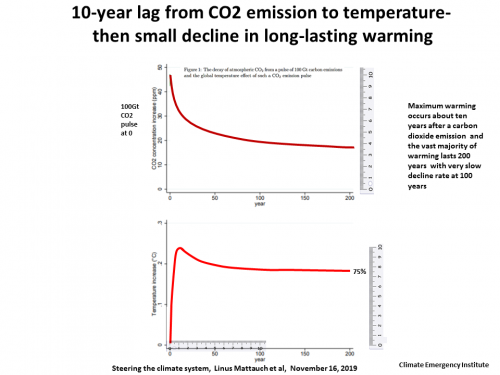
The IPCC 2001 3rd assessment Policy implications of inertia p.18 explains this well
The scientific way to estimate basic climate system commitment is from radiative forcing and the atmospheric CO2 equivalent, which includes the temperature effect of all atmospheric greenhouse emissions.
Today's (2023) atmospheric CO2 equivalent
is 523 ppm which is a long term
equilibrium commitment of 2.6°C
(sensitivity 3°C)
Today's (2023) atmospheric CO2 equivalent
is 523 ppm which is a long term
equilibrium commitment of 2.6°C
(sensitivity 3°C)
Jan 2021 research shows (locked-in) commitment by 2100 is over 1.5°C and full equilibrium warming is over 2°C
IPCC 2014 AR5 WG1 Chapter 12 (p.1108) on commitment (2012 data) said essentially the same. By 2100 an extra commitment of 0.6°C and about an extra 2°C
IPCC 2014 AR5 WG1 Chapter 12 (p.1108) on commitment (2012 data) said essentially the same. By 2100 an extra commitment of 0.6°C and about an extra 2°C

UK Met Office July 2019 Links between emissions pathways and time lags in Earth’s climate system

2020, C. Huntingford Latest CMIP6 models imply high committed warming
Sources There are many sources of climate science commitment that increase with temperature:
o Ocean thermal intertia
o Feedbacks -terrestrial (soil & vegetation), forest dieback, peatlands, permafrost,
o Failing carbon sinks
o Air pollution acid aerosols (cooling) Air pollution regulation and fossil fuel phaseout will increase global warming
o Ocean thermal intertia
o Feedbacks -terrestrial (soil & vegetation), forest dieback, peatlands, permafrost,
o Failing carbon sinks
o Air pollution acid aerosols (cooling) Air pollution regulation and fossil fuel phaseout will increase global warming
In all scenarios assessed here the central estimate of crossing the 1.5°C threshold lies in the early 2030s. (IPCC AR6, WG1, 4-555)
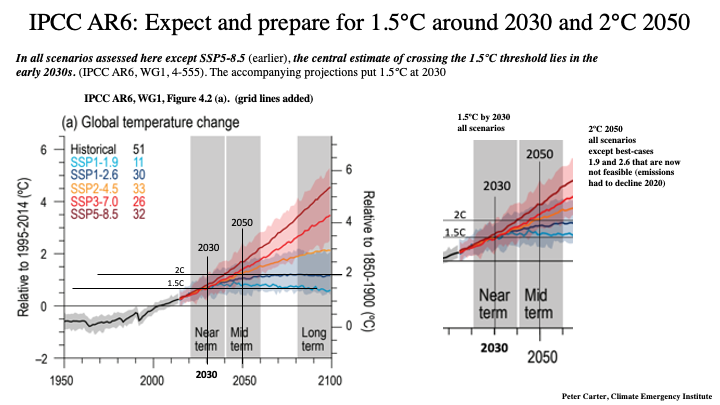
Future global surface heating and climate change commitment (much higher than today's) is the most important and most ignored aspect of the science
(it was covered best in the IPCC 2001 3rd assessment).
It is essential information in policy making.
(it was covered best in the IPCC 2001 3rd assessment).
It is essential information in policy making.
Definition There is actually no agreed on scientific definition of commitment
The IPCC gives several examples but they are all incomplete.
The (instant) zero emissions commitment (now routinely used) is only for modelling, has no policy relevance and is misleading in assessments.
The constant composition (no atmospheric GHGs increase) is useful but incomplete.
The IPCC gives several examples but they are all incomplete.
The (instant) zero emissions commitment (now routinely used) is only for modelling, has no policy relevance and is misleading in assessments.
The constant composition (no atmospheric GHGs increase) is useful but incomplete.
Today (20265) The world is absolutely committed to
an unavoidable globally disastrous warming of 1.5°C
by 2030 or soon after (IPCC AR6)
an unavoidable globally disastrous warming of 1.5°C
by 2030 or soon after (IPCC AR6)
The IPCC says and assessments show that to avoid the global and planetary catastrophic 2°C, global emissions have to decline immediately (2020) and rapidly. Today with emissions still being increased the world is committed to 2°C around 2050
All relevant versions of commitment puts the world above 2°C
Unavoidable future increased global climate change
Science has no agreed to single definition
For policy it is total warming,adding in alll sources of
unavoidable extra warming after strong mitigation
This is over 2°C
Science has no agreed to single definition
For policy it is total warming,adding in alll sources of
unavoidable extra warming after strong mitigation
This is over 2°C

This is due to climate system inertias mainly
from the very long atmospheric life-time of CO2 and
to threocean heat lag.
Even with best-case strong mitigation at 2020
it takes 20 to 30 years for temperature stabilization
to start
from the very long atmospheric life-time of CO2 and
to threocean heat lag.
Even with best-case strong mitigation at 2020
it takes 20 to 30 years for temperature stabilization
to start
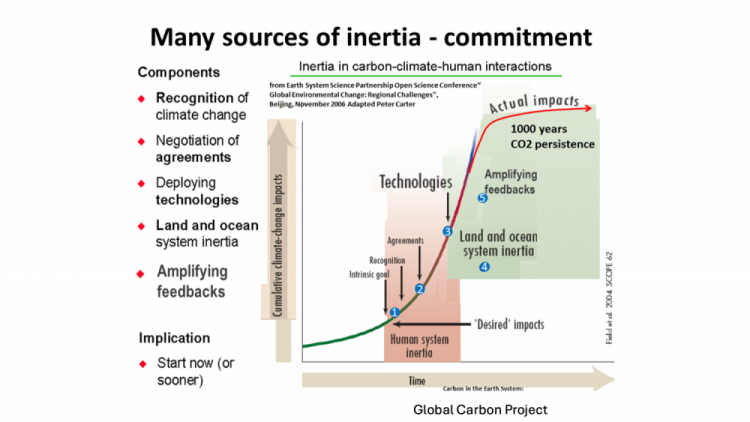
The climate system is characterized by its great inertia. The metaphor is the Titanic
IPCC AR6 on Commitment
pdf download
pdf download
Commitment has been described as locked in, burnt it and in the pipe. It can calculated from atmospheric CO2q. and radiative forcing.
From radiative forcing the Hansen at al 2023 Global warming in the pipeline found radiative forcing total warming including in the pipe is 2.4°C.
From radiative forcing the Hansen at al 2023 Global warming in the pipeline found radiative forcing total warming including in the pipe is 2.4°C.
Climate change assessment should assess impacts at committed warming, and mitigation should be based on this (practical) commitment.
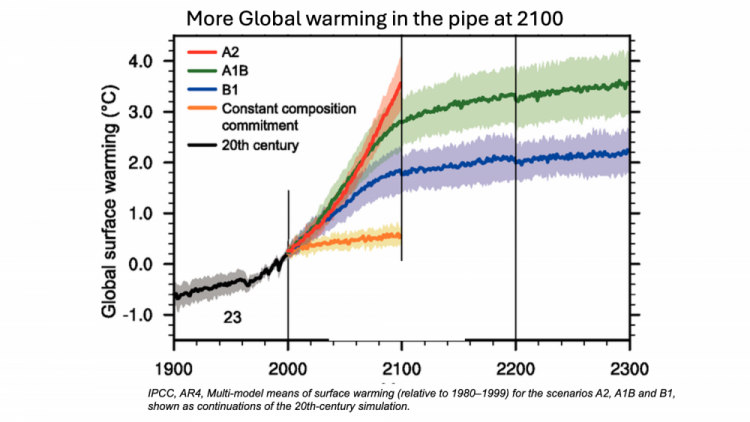
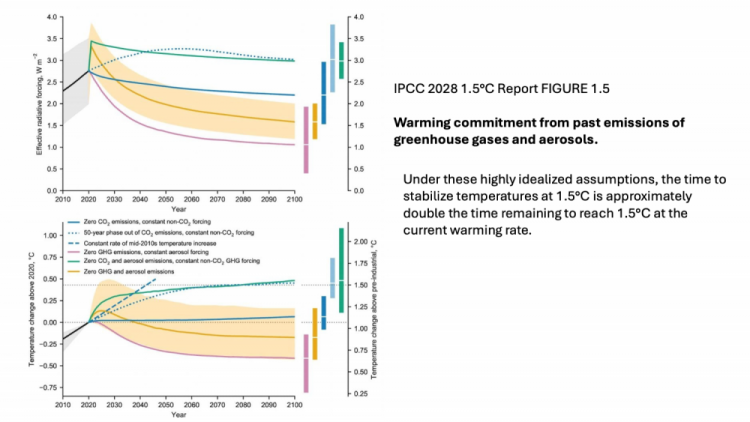
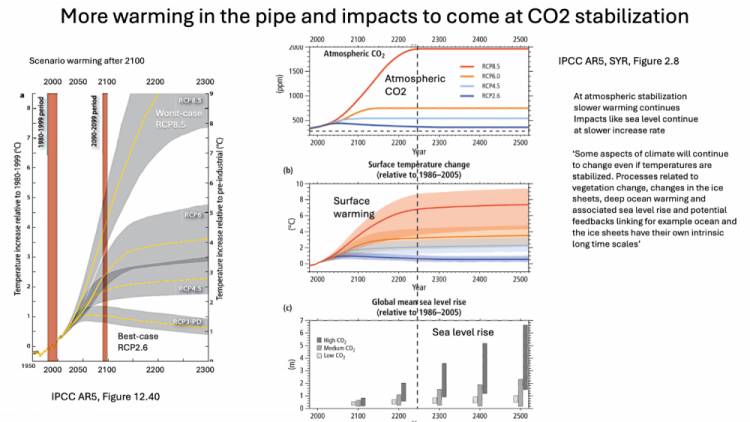
Best-case strong mitigation
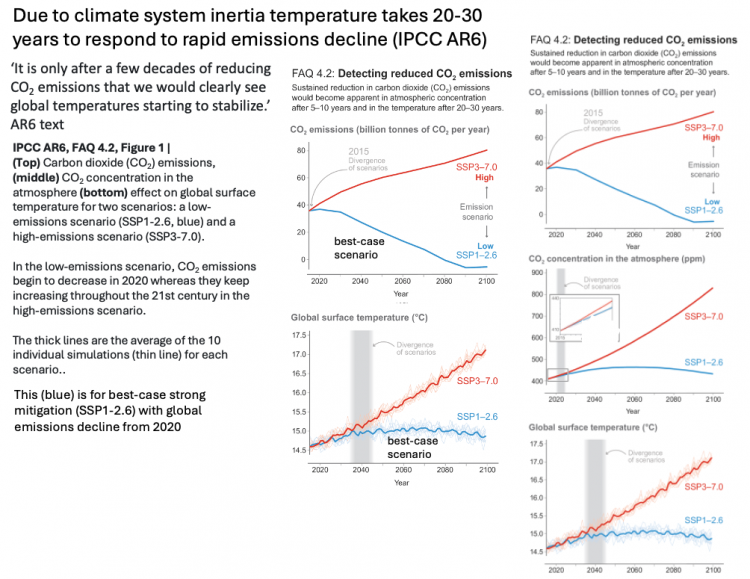
Double click here to edit this text.